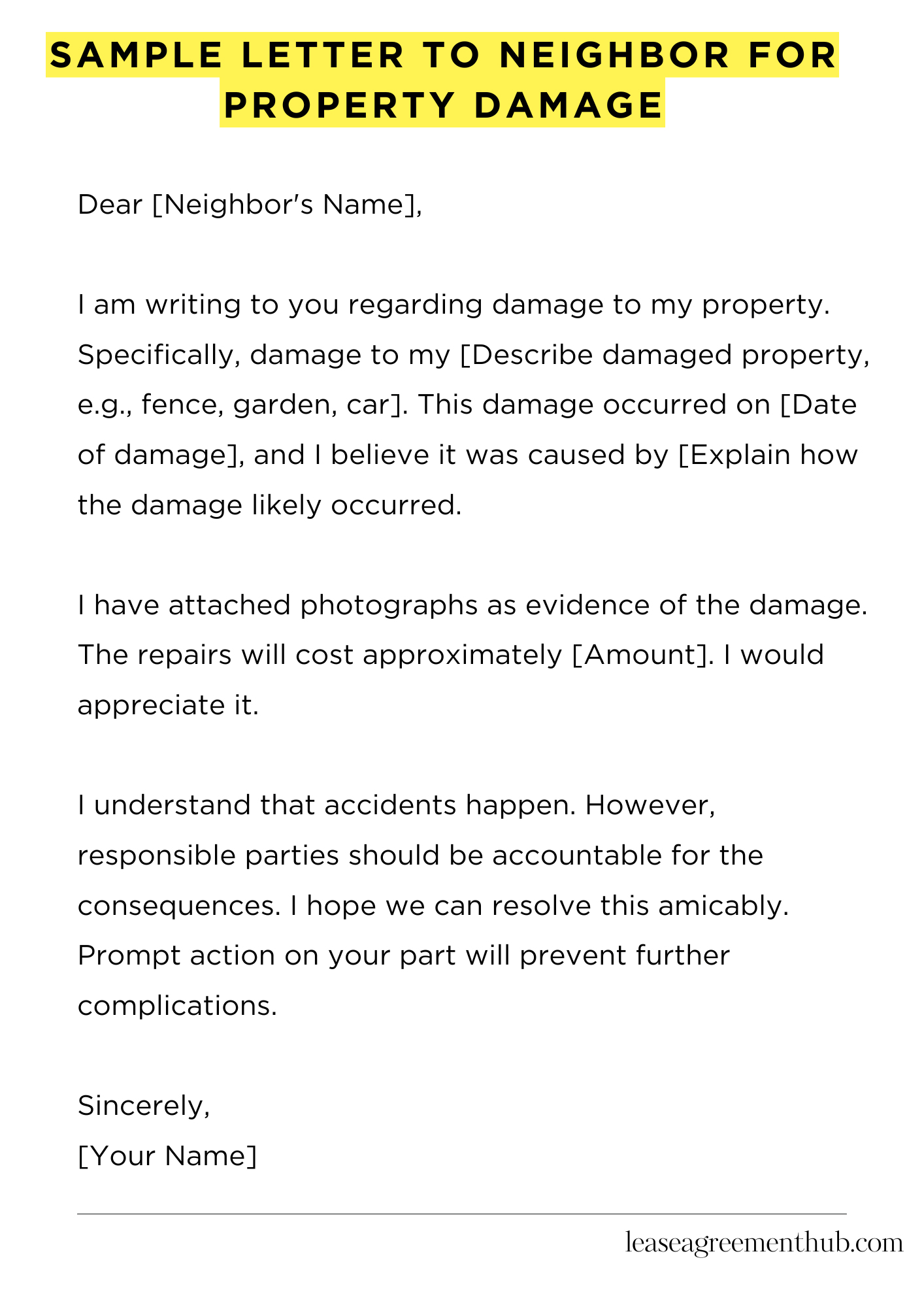Have you experienced property damage caused by your neighbor? Writing a letter to address the issue can help resolve the situation peacefully.
In this article, we will provide you with templates and examples of sample letters to send to your neighbor regarding property damage.
Whether it’s a fence, a tree, or any other type of property damage, our sample letters will make it easier for you to communicate your concerns effectively.
sample letter to neighbor for property damage
[Your Name]
[Your Address]
[Your Phone Number]
[Your Email Address]
[Date]
[Neighbor’s Name]
[Neighbor’s Address]
Dear [Neighbor’s Name],
I am writing to you regarding damage to my property. Specifically, damage to my [Describe damaged property, e.g., fence, garden, car]. This damage occurred on [Date of damage], and I believe it was caused by [Explain how the damage likely occurred, e.g., your dog, a falling tree from your property, etc.].
I have attached photographs as evidence of the damage. The repairs will cost approximately [Amount]. I would appreciate it if you would take responsibility for this and cover the cost of the repairs. Please let me know how you intend to address this matter within the next seven days.
I understand that accidents happen. However, responsible parties should be accountable for the consequences. I hope we can resolve this amicably. Prompt action on your part will prevent further complications.
Sincerely,
[Your Name]

How to Write a Sample Letter to Neighbor for Property Damage
Understanding the Nuances of Neighborly Disputes
Navigating disagreements with neighbors can be fraught with peril. A seemingly minor incident, such as property damage, can quickly escalate into a protracted and acrimonious feud. Therefore, a measured and documented approach is paramount. Effective communication is key to a successful resolution.
Documenting the Damage: A Crucial First Step
Before composing your letter, meticulously document the damage. Take numerous high-resolution photographs from various angles. Note the extent of the damage, the affected area, and any discernible cause. If possible, obtain corroborating evidence – witness statements or security footage would be advantageous. This comprehensive documentation will bolster your claim.
Crafting Your Salutation: Establishing a Tone of Civility
Begin your letter with a formal salutation, addressing your neighbor by their full name. Avoid jocular or overly familiar language. Your aim is to present your case clearly and professionally, not to exacerbate the situation. A measured, even tone is crucial for de-escalation.
Articulating the Problem: Clarity and Objectivity are Key
Clearly and concisely describe the incident that led to the property damage. Use precise language, avoiding hyperbole or emotionally charged terms. Stick to the facts. It’s imperative to avoid accusatory language, presenting your observations as objective statements of fact. A measured and factual account is far more persuasive than a rant.
Proposing a Resolution: A Path Towards Reconciliation
After outlining the problem, propose a reasonable solution. This could involve a joint assessment of the damage, a discussion on repair costs, or other mutually agreeable remedies. Demonstrating a willingness to collaborate fosters a more constructive dialogue and increases the likelihood of a peaceful resolution. Be prepared to compromise.
Maintaining a Professional and Respectful Demeanor
Throughout your letter, maintain a consistently professional and respectful tone. Avoid inflammatory language, personal attacks, or threats. Remember, your goal is to resolve the issue amicably; a belligerent approach will likely have the opposite effect. A conciliatory approach is often the most effective.
Concluding the Letter: A Call to Action and Contact Information
Conclude your letter by reiterating your desire for a swift and amicable resolution. Include your contact information – phone number and email address – making it easy for your neighbor to respond. A clear and concise call to action enhances the effectiveness of your correspondence. Follow-up if you don’t receive a timely response.
FAQs about sample letter to neighbor for property damage
What information should I include in a letter to my neighbor about property damage?
Your letter should clearly state the nature of the damage, when it occurred, how it occurred (if known), and the estimated cost of repair or replacement. Include specific details about the location of the damage and any supporting evidence you have (photos, witness statements).
How formal should my letter be?
While maintaining a polite and respectful tone is crucial, the level of formality depends on your relationship with your neighbor. A friendly, informal tone might be appropriate for a close neighbor, while a more formal tone is better for someone you don’t know well.
Should I mention my insurance company in the letter?
Mentioning your insurance company is generally not necessary in the initial letter. Focus on clearly outlining the damage and your expectation for resolution. Involving insurance should be a later step if a direct resolution isn’t reached.
What if my neighbor denies responsibility?
If your neighbor denies responsibility, your letter should reiterate the facts of the situation and any evidence you possess. Consider mentioning your intention to pursue further action if the matter remains unresolved, such as contacting your homeowner’s insurance or seeking legal counsel.
What is the best way to send the letter?
Sending the letter via certified mail with return receipt requested provides proof of delivery and can be helpful in case of future disputes. A simple hand-delivered letter is also acceptable, particularly if you have a good relationship with your neighbor. Keep a copy of the letter for your records.
Related: